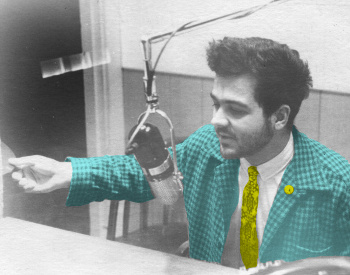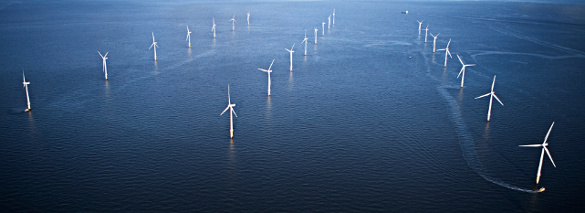Hurricane Damper
March 21, 2014
In my brief career in
commercial radio and television broadcasting in the
1960s, I worked with many cutting-edge
electronic devices of the era. These included some of the first
video tape recorders, costing more than half a million dollars in
today's money. This was also the era of
vinyl phonograph records played by a
stylus in a
spiral groove on
mechanical turntables by "
Top-40"
DJs.

""It all began at a small 5,000 watt radio station in Fresno, California…""
Actually, it was a small 1,000 watt radio station in Upstate New York.
(Author's photograph, circa 1968)]
Vinyl is a convenient
material for making phonograph records, since the addition of
plasticizers allows it to be
thermally molded. However, the same properties that allow for easy molding also make vinyl records susceptible to scratching, usually by rubbing the stylus across the grooves. Some stylus types are tipped with
industrial diamonds to prevent
wear.
The stylus is contained in a
tonearm assembly, and the desire to optimize performance of this
pivoted lever assembly with movement in two
axes led to some
innovations. A popular tonearm in radio stations was the Gray 108
transcription arm, which used a
silicone oil damping fluid to prevent sudden movements of the tonearm and prevented damage to records from accidental dropping.
Damping is the name for any process that
dissipates energy from a system. In the tonearm case, this was mechanical energy, but damping is useful in
electronic control systems to prevent
oscillation. When controlling a
motor, you don't want it to oscillate between a low and high speed state; instead, you want an even speed between these extremes. A team of
engineers at
Stanford University (Stanford, California) and the
University of Delaware (Newark, Delaware) has proposed that offshore
wind turbines can serve to dampen hurricanes.
As I wrote in some previous articles (
However the Wind Blows, February 7, 2012, and
Bigger than a Butterfly, "January 11, 2011) wind turbines modify the surface
Air flow. A 2004 study of a large
Great Plains wind farm showed that wind turbines significantly slow the wind at the turbine level, and they enhance vertical mixing of the
atmosphere.[1]
As a consequence, you can't space wind turbines too closely in a wind farm, since the upwind turbines modify the airflow to decrease the wind power available to the downwind turbines. As an example of this effect, the wind turbines of the
Horns Rev wind farm on the
coast of
Denmark are spaced seven
diameters apart, but the downstream turbines generate about a quarter less
power than the front row turbines.

Wind turbines at the Horns Rev wind farm. (Photo courtesy of Rune Birk Nielsen of DONG Energy)
Mark Z. Jacobson of Stanford University has teamed with Cristina L. Archer and Willett Kempton of the University of Delaware on computer simulation of the affect of large offshore wind farms on the strength of hurricanes.[2-4] They simulated three hurricanes; namely, Hurricane Katrina, which devastated New Orleans in 2005, Hurricane Sandy, which damaged a wide area around New York City in 2012, and Hurricane Isaac, which struck New Orleans in 2012. The results of these simulations have been published in a recent issue of Nature Climate Change.[2]
Jacobson has been modeling both hurricanes and wind farms for more than two decades, so he and his team were able to combine models to determine what affect offshore wind farms would have on the strength of hurricanes. Their study found that large offshore wind farms (300
gigawatts or more of installed capacity) could diminish a hurricane's peak near-surface wind speed by 56–92
miles per hour (mph), or 25–41
m/sec, and the
storm surge by 6-79%.[2-4]

Computer simulation of wind turbine affect on Hurricane Katrina.
The right side of the screen shows wind speed reductions (less red) with placement of offshore wind farms.
(Still image from a Stanford University YouTube video by Kurt Hickman.)
Turbines were effective when placed immediately upstream of a
city, or along the range of a
coastline.[2] The model found that an array of 78,000 wind turbines off the coast of New Orleans would have significantly reduced the strength of Hurricane Katrina, decreasing the wind speed by 80-98 mph (36-44 m/sec) and the storm surge by up to 79%.[3-4] Turbines would have reduced Hurricane Sandy's wind speed by 78-87 mph (35-39 m/sec) and the storm surge by as much as 34%. Says Jacobson,
"We found that when wind turbines are present, they slow down the outer rotation winds of a hurricane... This feeds back to decrease wave height, which reduces movement of air toward the center of the hurricane, increasing the central pressure, which in turn slows the winds of the entire hurricane and dissipates it faster."[3-4]
of course, tens of thousands of wind turbines would be expensive, but their generation of clean
electricity, plus damage reduction from hurricanes, would more than offset their cost. Hurricane Sandy caused about $80 billion in damage.[3-4] Massive
seawalls might protect cities, but at a cost of $10 billion to $40 billion per installation.[3-4]
Would offshore turbines withstand the onslaught of a hurricane? The present generation of wind turbines can withstand winds of 112 mph, the wind speed of a
category 2 to 3 hurricane. Also, the turbines would reduce the wind speed, so survivability is even more likely.[2]
References:
- S. Baidya Roy, S. W. Pacala and R. L. Walko, "Can large wind farms affect local meteorology?" J. Geophys. Res., vol. 109, 2004, D19101, doi:10.1029/2004JD004763. A PDF file is available here.
- Mark Z. Jacobson, Cristina L. Archer, and Willett Kempton, "Taming hurricanes with arrays of offshore wind turbines," Nature Climate Change, vol. 4, no. 3 (March, 2014), pp. 195-200 PDF file, available here. PDF file of supplementary Information, available here.
- Bjorn Carey, "Offshore wind farms could tame hurricanes before they reach land, Stanford-led study says," Stanford University Press Release, February 26, 2014.
- Bjorn Carey, "Offshore wind farms could tame hurricanes before they reach land, Stanford-led study says," Stanford University News, February 26, 2014.
- Stanford simulations show offshore wind farms could tame hurricanes, Stanford University YouTube video, February 26, 2014.
Permanent Link to this article
Linked Keywords: Commercial broadcasting; radio; television; 1960s; electronics; electronic device; videotape; video tape; tape recorder; time value of money; today's money; polyvinyl chloride; vinyl; phonograph record; stylus; spiral; mechanical turntable; contemporary hit radio; Top-40; radio personality; DJ; Ted Baxter; "It all began at a small 5,000 watt radio station in Fresno, California…"; Upstate New York; material; plasticizer; thermoplastic; thermally molded; industrial-grade diamonds; tribology; wear; tonearm; pivoted lever; axis; innovation; transcription disc; silicone oil; damping fluid; damping; dissipation; energy; electronic control system; oscillation; electric motor; engineer; Stanford University (Stanford, California); University of Delaware (Newark, Delaware); wind turbine; Air flow; Great Plains; atmosphere; Horns Rev; coast; Denmark; diameter; electric power; Mark Z. Jacobson; Cristina L. Archer; Willett Kempton; computer simulation; tropical cyclone; hurricane; Hurricane Katrina; New Orleans; Hurricane Sandy; New York City; Hurricane Isaac; Nature Climate Change; gigawatt; miles per hour; meters per second; m/sec; storm surge; YouTube; city; coastline; rotation; feedback; pressure; electricity; seawall.